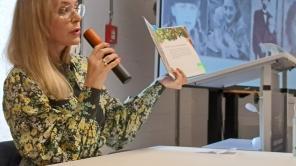Silhouettes with the yellow star

"Telling the Holocaust in pictures" is the title of the exhibition on current graphic novels and picture books at the Active Museum South Westphalia. It was developed and organized by the University of Siegen in cooperation with the Active Museum. In the picture (from left): Dr. Jens Aspelmeier, Prof. Dr. Daniel Stein, Dr. Jana Mikota and Britta Hönes.
They are part of the modern culture of remembrance: comics, graphic novels and picture books that deal with the Holocaust. They offer a different perspective because they tell the individual stories of victims and use the power, but also the distance, of images. Visitors to the Aktives Museum Südwestfalen can currently get to know various of these books and the stories behind their creation. The exhibition was created by Dr. Jana Mikota, Prof. Dr. Daniel Stein and Dr. Jens Aspelmeier. It is part of the joint project on Holocaust education, which began last winter semester at the University of Siegen. The German Department, the Department of English/American Studies and the Active Museum South Westphalia are all involved.
Just a quick glance at the exhibition posters with exemplary scenes is enough to memorize images: here delicately drawn silhouettes of people with the yellow star, there striking motifs such as the cat with Hitler's beard in front of the swastika. Dr. Jens Aspelmeier, Director of the Centre for Practical Teacher Training in Siegen and board member of the Active Museum, senses the irritation at the sight of the "Maus" comic. "That's part of it and is intentional on the part of the author." In the 1980s, Art Spiegelmann published "Maus", one of the first Holocaust comics, which sparked a controversial discussion about the appropriateness of its depiction. The book has since become a classic.
Spiegelmann used the story of his parents, who survived the Holocaust, as the basis for his comic. Other authors also focus on the stories of survivors. The visualization takes place after intensive conversations with the few remaining contemporary witnesses or their descendants and precise research.
The aim is always to bring memories to life and, above all, to give children and young people an introduction to this difficult topic. "The last survivors of the Shoah will die and we will no longer have any contemporary witnesses who can talk about persecution and extermination in schools, for example," explains Prof. Dr. Daniel Stein. Other forms of communication and other media must be found to talk to pupils about the Holocaust. "And we also need to show our students how they can communicate the topic later on." Graphic novels have the power to give new images to the biographies of Jews and other victims of the Nazi dictatorship. "Comics and picture books can connect the past and present through their depiction and the different way they are told," adds Dr. Jana Mikota. The drawings can also show what there are no concrete pictures of, for example the memories of the deceased, which Marion Goedelt shows as silhouettes with a yellow star in "Selma and Anton". It is a picture book for children. "The topic can also be addressed in elementary school," emphasizes Dr. Jana Mikota.
Stein, Aspelmeier and Mikota know that teachers are faced with a difficult task. "We are experiencing an increase in anti-Semitism," says Aspelmeier. "Of course, schools have a duty here, knowing full well that the Middle East conflict is dominating the discussion and shaping old and new anti-Semitic narratives." The consequence of this should never be to avoid the Holocaust as a subject in lessons. "On the contrary, it is all the more important to talk about the past, about Jewish life in Germany and about the Shoah," says Aspelmeier. "We need to develop further in terms of media education. Comics offer a valuable opportunity to do this."
Teacher trainee Britta Hönes, a research assistant on the project, can confirm this. During a school internship, she worked with graphic novels about the Holocaust. "The response from the pupils and the teacher was positive."
The illustrated panels, which were produced very successfully with the help of uniprint, the printing company of the University of Siegen, are also to be shown at schools and lent to other locations. The exhibition is suitable for all types of schools and is divided into different modules (primary and secondary schools).
The project on the culture of remembrance will continue at the University of Siegen. In the winter semester, there will be a hybrid lecture series entitled "Graphic storytelling, biography and the Holocaust". It will take place on Tuesdays from 6 to 8 p.m. on the Lower Castle Campus (US-C 105). Anyone interested is welcome to get in touch.
The exhibition led to close contact with the authors and illustrators and the idea of telling the biographies of Nazi victims from the Siegerland region in comics. A publisher already exists. The research is underway. A conference in November marks the start of the project implementation.
The exhibition at the Aktives Museum Südwestfalen can be seen until April 30, 2026. Open Tuesdays and Thursdays 3 to 6 pm and by appointment, Sundays 3 to 6 pm.
In detail
The exhibition is part of the project "Learning about the Shoah Through Narrative Art and Visual Storytelling" - Transnational Remembrance in Graphic Literature", which was initiated in the winter semester 2024/25 by Prof. Dr. Daniel Stein, Dr. Jens Aspelmeier and Dr. Jana Mikota. A lecture series and seminars offered students insights into current debates. The project was funded with 13,000 euros from the NRW Future Fund for Measures against Anti-Semitism in 2024.





